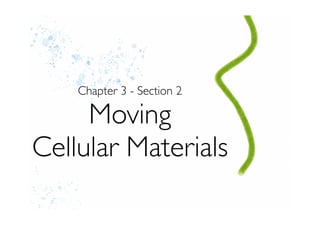
Moving Cellular Materials (3.2)
- 1. Chapter 3 - Section 2 Moving Cellular Materials
- 2. Selectively Permeable A cell’s membrane is selectively permeable. It allows some things to enter or leave the cell while keeping other things outside or inside the cell.
- 3. The way in which substances move through a cell membrane depends on: 1. the size of the particles 2. the path the substance takes through the membrane 3. whether or not energy is used
- 4. • The movement of substances through the cell membrane without the input of energy is called: passive transport • There are 3 types of passive transport: • diffusion • osmosis • facilitated diffusion
- 5. • Movement of solids, liquids, and gases from an area where there is relatively more of them into an area where there is relatively fewer of them is called diffusion. • This movement will continue until the relative number of these molecules is equal in the two areas. • When this occurs, equilibrium is reached and diffusion stops. diffusion
- 6. diffusion
- 7. diffusion
- 8. equilibrium
- 10. Air Sac in Lung lots of O2
- 11. Air Sac little of O2 in Lung Red lots of O2 blood cell
- 12. Air Sac little of O2 in Lung Red oxygen lots of O2 blood cell
- 13. lots of O2 Red blood cell skin cells little O2
- 14. lots of O2 Red blood cell oxygen skin cells little O2
- 15. skin cells lots of O2
- 16. skin cells lots of O2
- 17. • Water molecules move by diffusion into and out of cells. • The diffusion of water through a cell membrane is called osmosis. osmosis
- 18. osmosis
- 19. water moves across membrane osmosis
- 20. equilibrium
- 21. • Losing water from a plant cell causes its cell membrane to come away from its cell wall. • This reduces pressure against its cell wall, and a plant cell becomes limp. • Why would a plant cell lose water? • The concentration of substances (salt/sugar etc) is greater outside of the plant cell then inside it.
- 22. • If water around the cells would move into them, the cells would fill with water. • Their cell membranes would press against their cell walls. • Pressure would increase, and the cells would become firm. • Why would water enter the plant cell? • The concentration of substances inside the cell is greater then outside the cell.
- 23. Carrots & Eggs
- 24. • Some substances pass easily through the cell membrane by diffusion. • Other substances, such as glucose molecules, are so large that they can enter the cell only with the help of molecules in the cell membrane called transport proteins. • This process, a type of passive transport, is known as facilitated diffusion. facilitated diffusion
- 26. •3 types of Passive Transport: •diffusion •osmosis •facilitated diffusion Review
- 27. • Sometimes a substance is needed inside a cell even though the amount of that substance inside the cell is already greater than the amount outside the cell. • When an input of energy is required to move materials through a cell membrane, active transport takes place. active transport
- 29. active transport
- 30. active transport
- 31. active transport
- 32. The Process of Active Transport 1. The transport protein binds to the needed particle. 2. Energy is used to move the particle through the cell membrane. 3. The protein channel changes shape and pushes the particle. 4. The particle is released by the transport protein. active transport
- 33. • The roots of a plant already might contain more mineral molecules than the surrounding soil does. • Normally the mineral molecules move out of the root by diffusion or facilitated diffusion. But there are cases where the plant would still need more minerals. • The minerals would then need to move across the membrane and into the cell, from a low concentration to a high concentration. • To do this energy is needed.
- 34. • Large protein molecules and bacteria cannot enter a cell by diffusion or by using the cell membrane transport proteins. • They can enter by being Endocytosis surrounded by the cell membrane. and Exocytosis
- 35. • The cell membrane folds in on itself, enclosing the item in a sphere called a vesicle. • This process of taking substances into a cell by surrounding it with the cell membrane is called endocytosis. • Some one-celled organisms take in food this way.
- 38. • The contents of a vesicle can be released by a cell using the process called exocytosis. • The opposite process is called endocytosis. • A vesicle’s membrane fuses with a cell’s membrane, and the vesicle’s contents are released. • Cells in your stomach use this process to release chemicals that help digest food.
- 39. Turn to Page 81